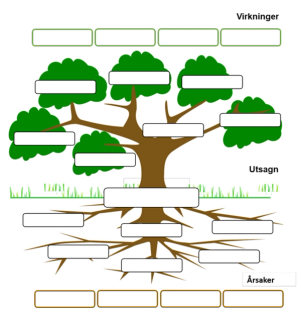About the activity
Objective
- The students are able to discuss and explain the correlation between the causes and effects of prejudiced and discriminatory speech. The students are able to reflect on the consequences of prejudiced or discriminatory speech. The students are able to discuss ways of dealing with prejudiced or discriminatory speech.
In this exercise, students are asked to reflect on prejudiced statements: What lies behind them, and how do they affect ourselves and others? The exercise can be used at the middle school level with some adjustments.
Preparation
Fordomstreet - Utskriftsmal
Skriv ut ett eksemplar av "Fordomstreet" til hver gruppe.

Implementation
Introduction
- 1
Explain that in order to be able to understand and respond to prejudiced and discriminatory speech, we need to look at the underlying causes such as the historical context or links to other issues.
1. Explain that in order to be able to understand and respond to prejudiced and discriminatory speech, we need to look at the underlying causes such as the historical context or links to other issues.
- 2
Display the “problem tree”.
2. Display the “problem tree”.
Display the “problem tree” and tell the students to work in groups to identify some of the circumstances, causes and backgrounds that lead to prejudice (the “roots”). Next, they should identify the effects and consequences of prejudice (the “branches”). You can use an example to illustrate this in detail.
- 3
“Roots”: find answers to the question “why does it happen?”
3. “Roots”: find answers to the question “why does it happen?”
- 4
“Branches”: find answers to the question “what can happen as a consequence of prejudiced speech?”
4. “Branches”: find answers to the question “what can happen as a consequence of prejudiced speech?”
Main Section
- 1
Split the students into groups and give each group the worksheet with the “problem tree”.
1. Split the students into groups and give each group the worksheet with the “problem tree”.
Choose a statement from the list below or make up your own, then ask the students to write the text inside the “trunk” of the tree.
- 2
Then ask them to complete as many “branches” and “roots” as they can. If they identify more “roots” or “branches” than there are text boxes, they can simply draw new ones.
2. Then ask them to complete as many “branches” and “roots” as they can. If they identify more “roots” or “branches” than there are text boxes, they can simply draw new ones.
They should imagine that the statement has been made online or in the classroom, in between lessons or elsewhere.
- 3
Give the groups 15 minutes or so to complete their trees.
3. Give the groups 15 minutes or so to complete their trees.
You can use the following examples of prejudiced speech. The examples demonstrate different levels of “seriousness” and can therefore encourage reflection on the impact of things we might say without being entirely conscious of it.
- PE teacher: “Last man across the line is a Jew.”
- Facebook: “Gypsies should get a job. Bloody scroungers.”
- Politician: “Society needs women who look after home and family.”
- Online comment: “Muslims are terrorists!”
- TV sports commentary: “The Germans are playing like a machine again.”
- On the bus: “Young people are lazy and selfish.”
- In a café: “Swedes are refusing to understand Norwegian.”
- Newspaper comment: “Norway is not a benefits office for the world.”
Closing reflections and summary
If the students have missed out important causes or effects, it may be a good idea to discuss them with the whole class.
Pick some of the roots, and brainstorm ways of dealing with them. If the students have identified “ignorance” as an underlying cause, you can ask them how the problem can be resolved.
The students can also circulate and look at each other’s trees. Can they spot any interesting differences between the trees?
To sum up, you can discuss the following questions:
- How easy was it to identify the roots? Talk about any problems or discussions within the groups.
- Do you think that knowledge of the causes and effects of prejudice can help you formulate a response to such speech or find ways of combating it?
